I solved the problem in the following way. I am not really happy with it since it looks to me much too complicated, but it works (please note that the code below is a simplified, untested version of my code, which is due to a different UI more complicated):
I have 3 properties that control scrolling:
@property (nonatomic, assign) CGFloat currentPanY;
@property (nonatomic, assign) BOOL scrollA;
@property (nonatomic, assign) BOOL scrollB;
2-step scrolling:
Disable scrolling for B, and enable scrolling for A.
This allows to scroll A .
When A reaches its max position, disable scrolling for A, and enable scrolling for B:
-(void)scrollViewDidScroll: (UIScrollView *)scrollView {
if (scrollView.contentOffset.y >= self.maxScrollUpOffset) {
[scrollView setContentOffset:CGPointMake(0, self.maxScrollUpOffset) animated:NO];
self.scrollviewA.scrollEnabled = NO;
self.scrollviewB.scrollEnabled = YES;
self.scrollB = YES;
}
}
This gives the following effect:
When A is scrolled upwards it will stop scrolling when its max size is reached. However B will not start scrolling, since the pan gesture recognizer of A does not forward its actions to the pan gesture recognizer of B. Thus one has to lift the finger and to start a 2nd scrolling. Then, B will scroll. This gives the 2-step scrolling.
Continuous scrolling:
For continuous scrolling, B must scroll while the finger that started scrolling of A continues moving upwards. To detect this, I added a further pan gesture recognizer tho A, and enabled it to detect gestures simultaneously with the built-in gesture recognizers of A and B:
- (BOOL)gestureRecognizer:(UIPanGestureRecognizer *)gestureRecognizer shouldRecognizeSimultaneouslyWithGestureRecognizer:(UISwipeGestureRecognizer *)otherGestureRecognizer {
return YES;
}
In the action of this additional pan gesture recognizer, I compute the distance the finger has moved upwards after the scrolling limit of A has been reached. By this distance, B is then scrolled programmatically:
- (void)panGestureRecognizerAction:(UIPanGestureRecognizer *)recognizer {
if (recognizer.state != UIGestureRecognizerStateChanged) {
self.currentPanY = 0;
self.scrollB = NO;
self.scrollA = NO;
} else {
CGPoint currentTranslation = [recognizer translationInView:self.scrollviewA];
CGFloat currentYup = currentTranslation.y;
if (self.scrollA || self.scrollB) {
if (self.currentPanY == 0) {
self.currentPanY = currentYup;
}
CGFloat additionalYup = self.currentPanY - currentYup;
if (self.scrollA) {
CGFloat offset = self.scrollviewA.scrollUpOffset + additionalYup;
if (offset >= 0) {
self.scrollviewA.contentOffset = CGPointMake(0, offset);
} else {
self.scrollviewA.contentOffset = CGPointZero;
}
} else if (self.scrollB){
self.scrollviewB.contentOffset = CGPointMake(0, additionalYup);
}
}
}
}
There is still a disadvantage:
If you start scrolling, lift the finger, and let the scrollView decelerate, it will behave like the 2-stage scrolling, since the additional pan gesture recognizer won’t recognize any pan gesture.

